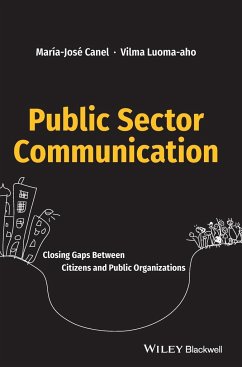María José Canel, Vilma Luoma-Aho
Public Sector Communication
Closing Gaps Between Citizens and Public Organizations
María José Canel, Vilma Luoma-Aho
Public Sector Communication
Closing Gaps Between Citizens and Public Organizations
- Gebundenes Buch
- Merkliste
- Auf die Merkliste
- Bewerten Bewerten
- Teilen
- Produkt teilen
- Produkterinnerung
- Produkterinnerung
Did You Know? This book is available as a Wiley E-Text. The Wiley E-Text is a complete digital version of the text that makes time spent studying more efficient. Course materials can be accessed on a desktop, laptop, or mobile device--so that learning can take place anytime, anywhere. A more affordable alternative to traditional print, the Wiley E-Text creates a flexible user experience: ✓ Access on-the-go ✓ Highlight and take notes ✓ Search across content ✓ Save money! The Wiley E-Text can be purchased in the following ways: Check with your bookstore for available e-textbook options Wiley…mehr
Andere Kunden interessierten sich auch für
![Public Sector Communication Public Sector Communication]() María José CanelPublic Sector Communication45,99 €
María José CanelPublic Sector Communication45,99 €![The Handbook of Communication Engagement The Handbook of Communication Engagement]() The Handbook of Communication Engagement236,99 €
The Handbook of Communication Engagement236,99 €![Terrorism and Public Safety Policing Terrorism and Public Safety Policing]() James F PastorTerrorism and Public Safety Policing197,99 €
James F PastorTerrorism and Public Safety Policing197,99 €![Policing and Public Management Policing and Public Management]() Kevin MorrellPolicing and Public Management196,99 €
Kevin MorrellPolicing and Public Management196,99 €![Gender Equality in Public Services Gender Equality in Public Services]() Hazel ConleyGender Equality in Public Services200,99 €
Hazel ConleyGender Equality in Public Services200,99 €![More Awesome Than Money More Awesome Than Money]() Jim DwyerMore Awesome Than Money15,99 €
Jim DwyerMore Awesome Than Money15,99 €![Crime, Media and Culture Crime, Media and Culture]() Greg MartinCrime, Media and Culture197,99 €
Greg MartinCrime, Media and Culture197,99 €-
-
-
Did You Know? This book is available as a Wiley E-Text. The Wiley E-Text is a complete digital version of the text that makes time spent studying more efficient. Course materials can be accessed on a desktop, laptop, or mobile device--so that learning can take place anytime, anywhere. A more affordable alternative to traditional print, the Wiley E-Text creates a flexible user experience: ✓ Access on-the-go ✓ Highlight and take notes ✓ Search across content ✓ Save money! The Wiley E-Text can be purchased in the following ways: Check with your bookstore for available e-textbook options Wiley E-text: Powered by VitalSource(R) ISBN: 978-1-119-13562-3 Directly from: www.wiley.com
Hinweis: Dieser Artikel kann nur an eine deutsche Lieferadresse ausgeliefert werden.
Hinweis: Dieser Artikel kann nur an eine deutsche Lieferadresse ausgeliefert werden.
Produktdetails
- Produktdetails
- Verlag: Wiley
- Seitenzahl: 276
- Erscheinungstermin: 31. Juli 2018
- Englisch
- Abmessung: 250mm x 175mm x 19mm
- Gewicht: 662g
- ISBN-13: 9781119135616
- ISBN-10: 1119135613
- Artikelnr.: 50450518
- Herstellerkennzeichnung
- Libri GmbH
- Europaallee 1
- 36244 Bad Hersfeld
- gpsr@libri.de
- Verlag: Wiley
- Seitenzahl: 276
- Erscheinungstermin: 31. Juli 2018
- Englisch
- Abmessung: 250mm x 175mm x 19mm
- Gewicht: 662g
- ISBN-13: 9781119135616
- ISBN-10: 1119135613
- Artikelnr.: 50450518
- Herstellerkennzeichnung
- Libri GmbH
- Europaallee 1
- 36244 Bad Hersfeld
- gpsr@libri.de
Maria-José Canel, University of Madrid, Madrid, Spain Vilma Luoma-aho, University of Jyväskylä, Jyväskylä, Finland
Part I 1 1 What Is Changing in Public Sector Communication? 3 1.1 The Change: Identifying the Gaps with Citizens 3 1.1.1 What Is Changing? 3 1.1.1.1 Change in Everyday Practice 3 1.1.1.2 Answering the Most Important Question 4 1.1.1.3 Changing Values? 5 1.1.2 Changes in Individuals: Citizens, Stakeholders, Customers, and Partners 5 1.1.2.1 Changes in Citizens' Demands and Expectations 6 1.1.2.2 Citizen Communication Practices 6 1.1.2.3 Citizen Diversity 6 1.1.2.4 Changing Citizen Roles 7 1.1.3 The Traditional Gaps that Citizens Perceive When Assessing the Public Sector 7 1.1.3.1 Citizens Are from Venus, Public Authorities Are from Mars? 7 1.1.3.2 Gap 1: Speed: Bureaucracy versus Postbureaucracy 8 1.1.3.3 Gap 2: Privacy: Public versus Private Communication 8 1.1.3.4 Gap 3: Viewpoints: Process versus Answers 8 1.1.3.5 Gap 4: Context: Single Events versus General Attitude 9 1.1.3.6 Gap 5: Perceptions: Perception versus Performance 9 1.1.3.7 Gap 6: Roles: Obligations versus Rights 10 1.1.3.8 Gap 7: Media Use: Controlled versus Real Time 10 1.2 Framework for the Book 11 1.2.1 What Has Been Done on Public Sector Communication? 11 1.2.1.1 Earliest Works 11 1.2.1.2 Little Development despite the Relevance of the Topic 11 1.2.1.3 Nomenclature 12 1.2.1.4 Mapping Contributions from Different Fields to the Study of Public Sector Communication 12 1.2.2 The Three Pillars of this Book 16 1.2.2.1 The Intangible Nature of Public Sector Management 16 1.2.2.2 Knowledge for Practice, Practice for Knowledge 17 1.2.2.3 Considering Public Sector Communication from an International Perspective 17 1.2.3 Plan of the Book 17 References 18 2 What Is So Special about Public Sector Communication? 25 2.1 What Is the Public Sector? 25 2.1.1 Initial Basic De
nitions 25 2.1.2 Is This Public or Private? 26 2.1.3 Scholarly Approaches to Establishing Criteria of Publicness 27 2.1.4 The Rings of Publicness 28 2.1.5 The Publicness Fan 28 2.2 De
ning Public Sector Communication 30 2.2.1 Mapping Scholarly De
nitions 30 2.2.2 Some Insights from Practice 32 2.2.3 Our De
nition of Public Sector Communication 33 2.3 Looking at Public Sector Communication from the Publicness Fan 33 2.3.1 Different Communication? 33 2.3.2 How Public Is This and Hence How Should Intangibles and Communication be Managed? 35 2.3.2.1 Funding and Pröt 36 2.3.2.2 "Ownership" and "Employees" 37 2.3.2.3 Control and Accountability 38 2.3.2.4 Purpose and Values 39 References 40 3 Fragile Public Sector Organizations 45 3.1 A Brief History of Public Sector Organizations' Development 45 3.2 Global Trends in Public Sector Management: An Overview 46 3.3 Is There a Need for Intangible Assets? 47 3.3.1 From New Public Management to New Public Service 47 3.3.2 From Management to Public Value 48 3.4 The Fragility of Public Sector Organizations 50 3.4.1 Distrust 50 3.4.2 Services and Experiences 51 3.4.3 Bureaucracy 52 3.4.4 The Political Dimension 52 3.4.5 A Tactical Approach 53 3.5 Expectations as a Cause for Public Sector Fragility 54 3.5.1 How Citizen Expectations Are Changing 54 3.5.2 Expectations through Experiences 56 3.5.3 Unmet Expectations 56 References 57 4 Antifragile Communication: Closing the Gap through Intangible Assets 65 4.1 De
ning "Intangible Asset" 65 4.1.1 What Is an Intangible Asset About? 65 4.1.2 Pinning Down Intangibility 66 4.1.3 The Features of an Intangible Asset 67 4.2 Types of Intangibles 67 4.2.1 Accounting Categorizations 67 4.2.2 Relationships and Perceptions as the Basis for Intangible Assets that Aim to Build Competitive Advantage 69 4.3 Why Are Intangibles Different in the Public Sector? 70 4.3.1 What Is the Value of Intangibility in the Public Sector? 72 4.3.2 Building Intangible Assets: Is It Possible? 73 4.4 Different Intangible Assets in the Public Sector 74 4.5 Avoiding Fragility through Intangible Assets 74 4.5.1 Antifragile Communication: Taking the Citizen Point of View 75 4.5.2 The Steps toward Antifragility 76 4.6 Intangible Assets in this Book 77 4.6.1 De
nition of Intangible Asset in the Public Sector 77 4.6.2 Different Intangible Assets and the Relationships between Them 78 References 79 Part II 83 5 Satisfaction 85 5.1 What Is Satisfaction? 85 5.2 Experiences and Satisfaction 86 5.3 Why Should Public Organizations Care About Citizen Satisfaction? 87 5.4 Communication and Satisfaction 88 5.5 Measuring Citizen Satisfaction 89 5.5.1 The Purpose of Measuring 89 5.5.2 Do Measurement Tools from the Private Sector Suit the Public Sector? 91 5.6 Summary of Citizen Satisfaction 92 5.7 Case Study on Citizen Satisfaction 93 5.8 Route Guide to Building Citizen Satisfaction 96 References 97 6 Organizational Culture 101 6.1 Organizations' Invisible Cultures 101 6.2 De
ning Organizational Culture 103 6.3 What Bene
t Does Organizational Culture Bring? 104 6.4 Public Sector Organizational Culture 105 6.5 Subcultures 106 6.6 Communication and Public Sector Culture 107 6.6.1 Gaps that Public Sector Culture Can Fix 107 6.6.2 What to Measure in Practice? 110 6.7 Changing Organizational Culture 110 6.8 Criticism of Organizational Culture 112 6.9 Summary of Organizational Culture 112 6.10 Case Study on Organizational Culture 113 6.11 Route Guide to Changing Organizational Culture 116 References 117 7 Reputation 121 7.1 What Is the Logic behind Organizational Reputation? 121 7.2 How the Digital Environment Shapes Reputation 122 7.3 Organizational Reputation De
ned 124 7.4 The Bene
ts of a Good Reputation 125 7.5 Public Sector Organizations and Reputation 126 7.5.1 Reputation in a Context of Lower Competition 126 7.5.2 Neutral Reputation as Ideal for Public Sector Organizations 127 7.6 Measuring Public Sector Reputation 128 7.7 Two Examples of Measuring Reputation 131 7.8 Summary of Public Sector Reputation 133 7.9 Route Guide to Building Organizational Reputation 135 References 136 8 Legitimacy 139 8.1 Conferring Legitimacy upon Public Sector Organizations: What Does It Mean? 139 8.2 The Legitimacy Judgment: What Confers Organizational Legitimacy in the Public Sector? 141 8.2.1 Achievements versus Procedures 141 8.2.2 Typologies of Legitimacy 141 8.2.3 Moral Legitimacy 142 8.3 Resources Generated by Legitimacy 143 8.4 Communication and Legitimacy Building 144 8.4.1 Being Acknowledged as Legitimate 145 8.4.2 Legitimacy Building as Sense Making 145 8.5 How Legitimacy Typologies Help Legitimacy Builders 146 8.6 Building Legitimacy 147 8.7 Critical Issues and Further Research 149 8.8 Summary of Legitimacy 151 8.9 Case Study on Legitimacy 151 8.10 Route Guide to Building Legitimacy 154 References 155 9 Intellectual Capital 159 9.1 What Intellectual Capital Is About 159 9.1.1 De
nition 159 9.1.2 What Has Been Done So Far on Intellectual Capital in the Public Sector? 160 9.2 Why is Intellectual Capital Needed? 161 9.3 What Resources Does Intellectual Capital Generate? Measuring Intellectual Capital 163 9.3.1 What Does Intellectual Capital Tell Us About? The Dimensions of IC 163 9.3.2 Measuring Intellectual Capital in the Public Sector 164 9.4 Communicating Intellectual Capital 166 9.4.1 Does Communication Play a Role in the Acknowledgement of Intellectual Capital? 166 9.4.2 Intellectual Capital Management and Communication Management 167 9.5 Critical Issues, Unanswered Questions, and Future Research 168 9.6 Summary of Intellectual Capital 169 9.7 Case Study on Intellectual Capital 170 9.8 Route Guide to Building Intellectual Capital 174 References 175 10 Engagement 179 10.1 What Citizen Engagement Is About 179 10.1.1 Looking at Engagement from the Citizen Side 179 10.1.2 Engagement from the Organization Side: The Role of Public Administrations in Engaging Citizens 180 10.2 Going Deeper into Public Sector Engagement 181 10.2.1 Governmental Efforts to Involve Citizens 182 10.2.2 Deepening Engagement: The Coproduction Perspective 182 10.3 Why Is Engagement Needed? 185 10.3.1 The Context for an Increasing Concern with and Practice of Citizen Engagement 185 10.3.2 What Speci
c Gaps Does Engagement Help to Bridge? 185 10.4 Outcomes of Engagement: Calibrating Its Value as an Intangible Asset 186 10.4.1 A General Positive Assessment of the Impact of Engagement 186 10.4.2 More Mixed Evidence that Cannot Be Disregarded 187 10.4.3 Engagement Effects for the Organization: The Managerial Side 188 10.4.4 Bene
t for Both Sides: The Cobene
t of Coproduction 188 10.5 Building and Communicating Engagement 189 10.6 Summary of Engagement 190 10.7 Case Study on Public Sector Engagement 191 10.8 Route Guide to Building Engagement 196 References 197 11 Social Capital 201 11.1 Theory of Social Capital 201 11.2 What Kind of Value Does Social Capital Produce? 203 11.3 What Kind of Gaps Does Social Capital Help to Bridge? 205 11.4 Communicating Social Capital 206 11.5 What Does This Mean for Public Sector Organizations' Communication Management? 207 11.6 Measuring Social Capital 209 11.7 Are All Networks Real? 210 11.8 Closing the Gap through Social Capital 211 11.9 Future Research on Social Capital 212 11.10 Summary of Social Capital 213 11.11 Case Study on Social Capital in the Public Sector 213 11.12 Route Guide to Building Social Capital 216 References 216 12 Trust 221 12.1 Why Does Trust Matter? The Intangible and Tangible Value of Trust 221 12.2 What Is Trust? 223 12.2.1 What is Trust About? 223 12.2.2 Can There Be Trust in Public Sector Organizations? 224 12.3 Trust in the Public Sector 224 12.3.1 Political Trust, Public Trust, and Trust in Government 225 12.3.2 Trust in Public Administration 226 12.3.3 Going Beyond the Public Administration: Trust in the Public Sector 226 12.4 Sources of Trust: What Generates Trust in the Public Sector? 227 12.4.1 Demographics 228 12.4.2 Political Attitudes as Explainers of Trust 228 12.4.3 The In
uence of Events Management 228 12.4.4 Performance as a Source of Trust 228 12.5 Other Intangible Assets as Causes of Trust 229 12.6 Trust and Communication: Building Trust 232 12.7 Critical Issues and Further Research 233 12.7.1 Is There a Trend of Decreasing Trust in Public Sector Organizations? 233 12.7.2 Debated Issues about Measuring Trust 235 12.8 Summary of Trust 236 References 237 13 Closing the Gaps 243 13.1 How Can We Close the Gap between Citizens and Public Sector Organizations? 243 13.1.1 Closing Gap 1: Speed: Bureaucracy versus Postbureaucracy 246 13.1.2 Closing Gap 2: Privacy: Public versus Private Communication 246 13.1.3 Closing Gap 3: Viewpoints: Process versus Answers 246 13.1.4 Closing Gap 4: Context: Single Events versus General Attitude 247 13.1.5 Closing Gap 5: Perceptions: Perception versus Performance 247 13.1.6 Closing Gap 6: Roles: Obligations versus Rights 247 13.1.7 Closing Gap 7: Media Use: Controlled versus Real Time 248 13.2 Expectations Management to Build Intangibles that Bridge Gaps 248 13.2.1 Concluding Remarks 252 References 253 Index 255
nitions 25 2.1.2 Is This Public or Private? 26 2.1.3 Scholarly Approaches to Establishing Criteria of Publicness 27 2.1.4 The Rings of Publicness 28 2.1.5 The Publicness Fan 28 2.2 De
ning Public Sector Communication 30 2.2.1 Mapping Scholarly De
nitions 30 2.2.2 Some Insights from Practice 32 2.2.3 Our De
nition of Public Sector Communication 33 2.3 Looking at Public Sector Communication from the Publicness Fan 33 2.3.1 Different Communication? 33 2.3.2 How Public Is This and Hence How Should Intangibles and Communication be Managed? 35 2.3.2.1 Funding and Pröt 36 2.3.2.2 "Ownership" and "Employees" 37 2.3.2.3 Control and Accountability 38 2.3.2.4 Purpose and Values 39 References 40 3 Fragile Public Sector Organizations 45 3.1 A Brief History of Public Sector Organizations' Development 45 3.2 Global Trends in Public Sector Management: An Overview 46 3.3 Is There a Need for Intangible Assets? 47 3.3.1 From New Public Management to New Public Service 47 3.3.2 From Management to Public Value 48 3.4 The Fragility of Public Sector Organizations 50 3.4.1 Distrust 50 3.4.2 Services and Experiences 51 3.4.3 Bureaucracy 52 3.4.4 The Political Dimension 52 3.4.5 A Tactical Approach 53 3.5 Expectations as a Cause for Public Sector Fragility 54 3.5.1 How Citizen Expectations Are Changing 54 3.5.2 Expectations through Experiences 56 3.5.3 Unmet Expectations 56 References 57 4 Antifragile Communication: Closing the Gap through Intangible Assets 65 4.1 De
ning "Intangible Asset" 65 4.1.1 What Is an Intangible Asset About? 65 4.1.2 Pinning Down Intangibility 66 4.1.3 The Features of an Intangible Asset 67 4.2 Types of Intangibles 67 4.2.1 Accounting Categorizations 67 4.2.2 Relationships and Perceptions as the Basis for Intangible Assets that Aim to Build Competitive Advantage 69 4.3 Why Are Intangibles Different in the Public Sector? 70 4.3.1 What Is the Value of Intangibility in the Public Sector? 72 4.3.2 Building Intangible Assets: Is It Possible? 73 4.4 Different Intangible Assets in the Public Sector 74 4.5 Avoiding Fragility through Intangible Assets 74 4.5.1 Antifragile Communication: Taking the Citizen Point of View 75 4.5.2 The Steps toward Antifragility 76 4.6 Intangible Assets in this Book 77 4.6.1 De
nition of Intangible Asset in the Public Sector 77 4.6.2 Different Intangible Assets and the Relationships between Them 78 References 79 Part II 83 5 Satisfaction 85 5.1 What Is Satisfaction? 85 5.2 Experiences and Satisfaction 86 5.3 Why Should Public Organizations Care About Citizen Satisfaction? 87 5.4 Communication and Satisfaction 88 5.5 Measuring Citizen Satisfaction 89 5.5.1 The Purpose of Measuring 89 5.5.2 Do Measurement Tools from the Private Sector Suit the Public Sector? 91 5.6 Summary of Citizen Satisfaction 92 5.7 Case Study on Citizen Satisfaction 93 5.8 Route Guide to Building Citizen Satisfaction 96 References 97 6 Organizational Culture 101 6.1 Organizations' Invisible Cultures 101 6.2 De
ning Organizational Culture 103 6.3 What Bene
t Does Organizational Culture Bring? 104 6.4 Public Sector Organizational Culture 105 6.5 Subcultures 106 6.6 Communication and Public Sector Culture 107 6.6.1 Gaps that Public Sector Culture Can Fix 107 6.6.2 What to Measure in Practice? 110 6.7 Changing Organizational Culture 110 6.8 Criticism of Organizational Culture 112 6.9 Summary of Organizational Culture 112 6.10 Case Study on Organizational Culture 113 6.11 Route Guide to Changing Organizational Culture 116 References 117 7 Reputation 121 7.1 What Is the Logic behind Organizational Reputation? 121 7.2 How the Digital Environment Shapes Reputation 122 7.3 Organizational Reputation De
ned 124 7.4 The Bene
ts of a Good Reputation 125 7.5 Public Sector Organizations and Reputation 126 7.5.1 Reputation in a Context of Lower Competition 126 7.5.2 Neutral Reputation as Ideal for Public Sector Organizations 127 7.6 Measuring Public Sector Reputation 128 7.7 Two Examples of Measuring Reputation 131 7.8 Summary of Public Sector Reputation 133 7.9 Route Guide to Building Organizational Reputation 135 References 136 8 Legitimacy 139 8.1 Conferring Legitimacy upon Public Sector Organizations: What Does It Mean? 139 8.2 The Legitimacy Judgment: What Confers Organizational Legitimacy in the Public Sector? 141 8.2.1 Achievements versus Procedures 141 8.2.2 Typologies of Legitimacy 141 8.2.3 Moral Legitimacy 142 8.3 Resources Generated by Legitimacy 143 8.4 Communication and Legitimacy Building 144 8.4.1 Being Acknowledged as Legitimate 145 8.4.2 Legitimacy Building as Sense Making 145 8.5 How Legitimacy Typologies Help Legitimacy Builders 146 8.6 Building Legitimacy 147 8.7 Critical Issues and Further Research 149 8.8 Summary of Legitimacy 151 8.9 Case Study on Legitimacy 151 8.10 Route Guide to Building Legitimacy 154 References 155 9 Intellectual Capital 159 9.1 What Intellectual Capital Is About 159 9.1.1 De
nition 159 9.1.2 What Has Been Done So Far on Intellectual Capital in the Public Sector? 160 9.2 Why is Intellectual Capital Needed? 161 9.3 What Resources Does Intellectual Capital Generate? Measuring Intellectual Capital 163 9.3.1 What Does Intellectual Capital Tell Us About? The Dimensions of IC 163 9.3.2 Measuring Intellectual Capital in the Public Sector 164 9.4 Communicating Intellectual Capital 166 9.4.1 Does Communication Play a Role in the Acknowledgement of Intellectual Capital? 166 9.4.2 Intellectual Capital Management and Communication Management 167 9.5 Critical Issues, Unanswered Questions, and Future Research 168 9.6 Summary of Intellectual Capital 169 9.7 Case Study on Intellectual Capital 170 9.8 Route Guide to Building Intellectual Capital 174 References 175 10 Engagement 179 10.1 What Citizen Engagement Is About 179 10.1.1 Looking at Engagement from the Citizen Side 179 10.1.2 Engagement from the Organization Side: The Role of Public Administrations in Engaging Citizens 180 10.2 Going Deeper into Public Sector Engagement 181 10.2.1 Governmental Efforts to Involve Citizens 182 10.2.2 Deepening Engagement: The Coproduction Perspective 182 10.3 Why Is Engagement Needed? 185 10.3.1 The Context for an Increasing Concern with and Practice of Citizen Engagement 185 10.3.2 What Speci
c Gaps Does Engagement Help to Bridge? 185 10.4 Outcomes of Engagement: Calibrating Its Value as an Intangible Asset 186 10.4.1 A General Positive Assessment of the Impact of Engagement 186 10.4.2 More Mixed Evidence that Cannot Be Disregarded 187 10.4.3 Engagement Effects for the Organization: The Managerial Side 188 10.4.4 Bene
t for Both Sides: The Cobene
t of Coproduction 188 10.5 Building and Communicating Engagement 189 10.6 Summary of Engagement 190 10.7 Case Study on Public Sector Engagement 191 10.8 Route Guide to Building Engagement 196 References 197 11 Social Capital 201 11.1 Theory of Social Capital 201 11.2 What Kind of Value Does Social Capital Produce? 203 11.3 What Kind of Gaps Does Social Capital Help to Bridge? 205 11.4 Communicating Social Capital 206 11.5 What Does This Mean for Public Sector Organizations' Communication Management? 207 11.6 Measuring Social Capital 209 11.7 Are All Networks Real? 210 11.8 Closing the Gap through Social Capital 211 11.9 Future Research on Social Capital 212 11.10 Summary of Social Capital 213 11.11 Case Study on Social Capital in the Public Sector 213 11.12 Route Guide to Building Social Capital 216 References 216 12 Trust 221 12.1 Why Does Trust Matter? The Intangible and Tangible Value of Trust 221 12.2 What Is Trust? 223 12.2.1 What is Trust About? 223 12.2.2 Can There Be Trust in Public Sector Organizations? 224 12.3 Trust in the Public Sector 224 12.3.1 Political Trust, Public Trust, and Trust in Government 225 12.3.2 Trust in Public Administration 226 12.3.3 Going Beyond the Public Administration: Trust in the Public Sector 226 12.4 Sources of Trust: What Generates Trust in the Public Sector? 227 12.4.1 Demographics 228 12.4.2 Political Attitudes as Explainers of Trust 228 12.4.3 The In
uence of Events Management 228 12.4.4 Performance as a Source of Trust 228 12.5 Other Intangible Assets as Causes of Trust 229 12.6 Trust and Communication: Building Trust 232 12.7 Critical Issues and Further Research 233 12.7.1 Is There a Trend of Decreasing Trust in Public Sector Organizations? 233 12.7.2 Debated Issues about Measuring Trust 235 12.8 Summary of Trust 236 References 237 13 Closing the Gaps 243 13.1 How Can We Close the Gap between Citizens and Public Sector Organizations? 243 13.1.1 Closing Gap 1: Speed: Bureaucracy versus Postbureaucracy 246 13.1.2 Closing Gap 2: Privacy: Public versus Private Communication 246 13.1.3 Closing Gap 3: Viewpoints: Process versus Answers 246 13.1.4 Closing Gap 4: Context: Single Events versus General Attitude 247 13.1.5 Closing Gap 5: Perceptions: Perception versus Performance 247 13.1.6 Closing Gap 6: Roles: Obligations versus Rights 247 13.1.7 Closing Gap 7: Media Use: Controlled versus Real Time 248 13.2 Expectations Management to Build Intangibles that Bridge Gaps 248 13.2.1 Concluding Remarks 252 References 253 Index 255
Part I 1 1 What Is Changing in Public Sector Communication? 3 1.1 The Change: Identifying the Gaps with Citizens 3 1.1.1 What Is Changing? 3 1.1.1.1 Change in Everyday Practice 3 1.1.1.2 Answering the Most Important Question 4 1.1.1.3 Changing Values? 5 1.1.2 Changes in Individuals: Citizens, Stakeholders, Customers, and Partners 5 1.1.2.1 Changes in Citizens' Demands and Expectations 6 1.1.2.2 Citizen Communication Practices 6 1.1.2.3 Citizen Diversity 6 1.1.2.4 Changing Citizen Roles 7 1.1.3 The Traditional Gaps that Citizens Perceive When Assessing the Public Sector 7 1.1.3.1 Citizens Are from Venus, Public Authorities Are from Mars? 7 1.1.3.2 Gap 1: Speed: Bureaucracy versus Postbureaucracy 8 1.1.3.3 Gap 2: Privacy: Public versus Private Communication 8 1.1.3.4 Gap 3: Viewpoints: Process versus Answers 8 1.1.3.5 Gap 4: Context: Single Events versus General Attitude 9 1.1.3.6 Gap 5: Perceptions: Perception versus Performance 9 1.1.3.7 Gap 6: Roles: Obligations versus Rights 10 1.1.3.8 Gap 7: Media Use: Controlled versus Real Time 10 1.2 Framework for the Book 11 1.2.1 What Has Been Done on Public Sector Communication? 11 1.2.1.1 Earliest Works 11 1.2.1.2 Little Development despite the Relevance of the Topic 11 1.2.1.3 Nomenclature 12 1.2.1.4 Mapping Contributions from Different Fields to the Study of Public Sector Communication 12 1.2.2 The Three Pillars of this Book 16 1.2.2.1 The Intangible Nature of Public Sector Management 16 1.2.2.2 Knowledge for Practice, Practice for Knowledge 17 1.2.2.3 Considering Public Sector Communication from an International Perspective 17 1.2.3 Plan of the Book 17 References 18 2 What Is So Special about Public Sector Communication? 25 2.1 What Is the Public Sector? 25 2.1.1 Initial Basic De
nitions 25 2.1.2 Is This Public or Private? 26 2.1.3 Scholarly Approaches to Establishing Criteria of Publicness 27 2.1.4 The Rings of Publicness 28 2.1.5 The Publicness Fan 28 2.2 De
ning Public Sector Communication 30 2.2.1 Mapping Scholarly De
nitions 30 2.2.2 Some Insights from Practice 32 2.2.3 Our De
nition of Public Sector Communication 33 2.3 Looking at Public Sector Communication from the Publicness Fan 33 2.3.1 Different Communication? 33 2.3.2 How Public Is This and Hence How Should Intangibles and Communication be Managed? 35 2.3.2.1 Funding and Pröt 36 2.3.2.2 "Ownership" and "Employees" 37 2.3.2.3 Control and Accountability 38 2.3.2.4 Purpose and Values 39 References 40 3 Fragile Public Sector Organizations 45 3.1 A Brief History of Public Sector Organizations' Development 45 3.2 Global Trends in Public Sector Management: An Overview 46 3.3 Is There a Need for Intangible Assets? 47 3.3.1 From New Public Management to New Public Service 47 3.3.2 From Management to Public Value 48 3.4 The Fragility of Public Sector Organizations 50 3.4.1 Distrust 50 3.4.2 Services and Experiences 51 3.4.3 Bureaucracy 52 3.4.4 The Political Dimension 52 3.4.5 A Tactical Approach 53 3.5 Expectations as a Cause for Public Sector Fragility 54 3.5.1 How Citizen Expectations Are Changing 54 3.5.2 Expectations through Experiences 56 3.5.3 Unmet Expectations 56 References 57 4 Antifragile Communication: Closing the Gap through Intangible Assets 65 4.1 De
ning "Intangible Asset" 65 4.1.1 What Is an Intangible Asset About? 65 4.1.2 Pinning Down Intangibility 66 4.1.3 The Features of an Intangible Asset 67 4.2 Types of Intangibles 67 4.2.1 Accounting Categorizations 67 4.2.2 Relationships and Perceptions as the Basis for Intangible Assets that Aim to Build Competitive Advantage 69 4.3 Why Are Intangibles Different in the Public Sector? 70 4.3.1 What Is the Value of Intangibility in the Public Sector? 72 4.3.2 Building Intangible Assets: Is It Possible? 73 4.4 Different Intangible Assets in the Public Sector 74 4.5 Avoiding Fragility through Intangible Assets 74 4.5.1 Antifragile Communication: Taking the Citizen Point of View 75 4.5.2 The Steps toward Antifragility 76 4.6 Intangible Assets in this Book 77 4.6.1 De
nition of Intangible Asset in the Public Sector 77 4.6.2 Different Intangible Assets and the Relationships between Them 78 References 79 Part II 83 5 Satisfaction 85 5.1 What Is Satisfaction? 85 5.2 Experiences and Satisfaction 86 5.3 Why Should Public Organizations Care About Citizen Satisfaction? 87 5.4 Communication and Satisfaction 88 5.5 Measuring Citizen Satisfaction 89 5.5.1 The Purpose of Measuring 89 5.5.2 Do Measurement Tools from the Private Sector Suit the Public Sector? 91 5.6 Summary of Citizen Satisfaction 92 5.7 Case Study on Citizen Satisfaction 93 5.8 Route Guide to Building Citizen Satisfaction 96 References 97 6 Organizational Culture 101 6.1 Organizations' Invisible Cultures 101 6.2 De
ning Organizational Culture 103 6.3 What Bene
t Does Organizational Culture Bring? 104 6.4 Public Sector Organizational Culture 105 6.5 Subcultures 106 6.6 Communication and Public Sector Culture 107 6.6.1 Gaps that Public Sector Culture Can Fix 107 6.6.2 What to Measure in Practice? 110 6.7 Changing Organizational Culture 110 6.8 Criticism of Organizational Culture 112 6.9 Summary of Organizational Culture 112 6.10 Case Study on Organizational Culture 113 6.11 Route Guide to Changing Organizational Culture 116 References 117 7 Reputation 121 7.1 What Is the Logic behind Organizational Reputation? 121 7.2 How the Digital Environment Shapes Reputation 122 7.3 Organizational Reputation De
ned 124 7.4 The Bene
ts of a Good Reputation 125 7.5 Public Sector Organizations and Reputation 126 7.5.1 Reputation in a Context of Lower Competition 126 7.5.2 Neutral Reputation as Ideal for Public Sector Organizations 127 7.6 Measuring Public Sector Reputation 128 7.7 Two Examples of Measuring Reputation 131 7.8 Summary of Public Sector Reputation 133 7.9 Route Guide to Building Organizational Reputation 135 References 136 8 Legitimacy 139 8.1 Conferring Legitimacy upon Public Sector Organizations: What Does It Mean? 139 8.2 The Legitimacy Judgment: What Confers Organizational Legitimacy in the Public Sector? 141 8.2.1 Achievements versus Procedures 141 8.2.2 Typologies of Legitimacy 141 8.2.3 Moral Legitimacy 142 8.3 Resources Generated by Legitimacy 143 8.4 Communication and Legitimacy Building 144 8.4.1 Being Acknowledged as Legitimate 145 8.4.2 Legitimacy Building as Sense Making 145 8.5 How Legitimacy Typologies Help Legitimacy Builders 146 8.6 Building Legitimacy 147 8.7 Critical Issues and Further Research 149 8.8 Summary of Legitimacy 151 8.9 Case Study on Legitimacy 151 8.10 Route Guide to Building Legitimacy 154 References 155 9 Intellectual Capital 159 9.1 What Intellectual Capital Is About 159 9.1.1 De
nition 159 9.1.2 What Has Been Done So Far on Intellectual Capital in the Public Sector? 160 9.2 Why is Intellectual Capital Needed? 161 9.3 What Resources Does Intellectual Capital Generate? Measuring Intellectual Capital 163 9.3.1 What Does Intellectual Capital Tell Us About? The Dimensions of IC 163 9.3.2 Measuring Intellectual Capital in the Public Sector 164 9.4 Communicating Intellectual Capital 166 9.4.1 Does Communication Play a Role in the Acknowledgement of Intellectual Capital? 166 9.4.2 Intellectual Capital Management and Communication Management 167 9.5 Critical Issues, Unanswered Questions, and Future Research 168 9.6 Summary of Intellectual Capital 169 9.7 Case Study on Intellectual Capital 170 9.8 Route Guide to Building Intellectual Capital 174 References 175 10 Engagement 179 10.1 What Citizen Engagement Is About 179 10.1.1 Looking at Engagement from the Citizen Side 179 10.1.2 Engagement from the Organization Side: The Role of Public Administrations in Engaging Citizens 180 10.2 Going Deeper into Public Sector Engagement 181 10.2.1 Governmental Efforts to Involve Citizens 182 10.2.2 Deepening Engagement: The Coproduction Perspective 182 10.3 Why Is Engagement Needed? 185 10.3.1 The Context for an Increasing Concern with and Practice of Citizen Engagement 185 10.3.2 What Speci
c Gaps Does Engagement Help to Bridge? 185 10.4 Outcomes of Engagement: Calibrating Its Value as an Intangible Asset 186 10.4.1 A General Positive Assessment of the Impact of Engagement 186 10.4.2 More Mixed Evidence that Cannot Be Disregarded 187 10.4.3 Engagement Effects for the Organization: The Managerial Side 188 10.4.4 Bene
t for Both Sides: The Cobene
t of Coproduction 188 10.5 Building and Communicating Engagement 189 10.6 Summary of Engagement 190 10.7 Case Study on Public Sector Engagement 191 10.8 Route Guide to Building Engagement 196 References 197 11 Social Capital 201 11.1 Theory of Social Capital 201 11.2 What Kind of Value Does Social Capital Produce? 203 11.3 What Kind of Gaps Does Social Capital Help to Bridge? 205 11.4 Communicating Social Capital 206 11.5 What Does This Mean for Public Sector Organizations' Communication Management? 207 11.6 Measuring Social Capital 209 11.7 Are All Networks Real? 210 11.8 Closing the Gap through Social Capital 211 11.9 Future Research on Social Capital 212 11.10 Summary of Social Capital 213 11.11 Case Study on Social Capital in the Public Sector 213 11.12 Route Guide to Building Social Capital 216 References 216 12 Trust 221 12.1 Why Does Trust Matter? The Intangible and Tangible Value of Trust 221 12.2 What Is Trust? 223 12.2.1 What is Trust About? 223 12.2.2 Can There Be Trust in Public Sector Organizations? 224 12.3 Trust in the Public Sector 224 12.3.1 Political Trust, Public Trust, and Trust in Government 225 12.3.2 Trust in Public Administration 226 12.3.3 Going Beyond the Public Administration: Trust in the Public Sector 226 12.4 Sources of Trust: What Generates Trust in the Public Sector? 227 12.4.1 Demographics 228 12.4.2 Political Attitudes as Explainers of Trust 228 12.4.3 The In
uence of Events Management 228 12.4.4 Performance as a Source of Trust 228 12.5 Other Intangible Assets as Causes of Trust 229 12.6 Trust and Communication: Building Trust 232 12.7 Critical Issues and Further Research 233 12.7.1 Is There a Trend of Decreasing Trust in Public Sector Organizations? 233 12.7.2 Debated Issues about Measuring Trust 235 12.8 Summary of Trust 236 References 237 13 Closing the Gaps 243 13.1 How Can We Close the Gap between Citizens and Public Sector Organizations? 243 13.1.1 Closing Gap 1: Speed: Bureaucracy versus Postbureaucracy 246 13.1.2 Closing Gap 2: Privacy: Public versus Private Communication 246 13.1.3 Closing Gap 3: Viewpoints: Process versus Answers 246 13.1.4 Closing Gap 4: Context: Single Events versus General Attitude 247 13.1.5 Closing Gap 5: Perceptions: Perception versus Performance 247 13.1.6 Closing Gap 6: Roles: Obligations versus Rights 247 13.1.7 Closing Gap 7: Media Use: Controlled versus Real Time 248 13.2 Expectations Management to Build Intangibles that Bridge Gaps 248 13.2.1 Concluding Remarks 252 References 253 Index 255
nitions 25 2.1.2 Is This Public or Private? 26 2.1.3 Scholarly Approaches to Establishing Criteria of Publicness 27 2.1.4 The Rings of Publicness 28 2.1.5 The Publicness Fan 28 2.2 De
ning Public Sector Communication 30 2.2.1 Mapping Scholarly De
nitions 30 2.2.2 Some Insights from Practice 32 2.2.3 Our De
nition of Public Sector Communication 33 2.3 Looking at Public Sector Communication from the Publicness Fan 33 2.3.1 Different Communication? 33 2.3.2 How Public Is This and Hence How Should Intangibles and Communication be Managed? 35 2.3.2.1 Funding and Pröt 36 2.3.2.2 "Ownership" and "Employees" 37 2.3.2.3 Control and Accountability 38 2.3.2.4 Purpose and Values 39 References 40 3 Fragile Public Sector Organizations 45 3.1 A Brief History of Public Sector Organizations' Development 45 3.2 Global Trends in Public Sector Management: An Overview 46 3.3 Is There a Need for Intangible Assets? 47 3.3.1 From New Public Management to New Public Service 47 3.3.2 From Management to Public Value 48 3.4 The Fragility of Public Sector Organizations 50 3.4.1 Distrust 50 3.4.2 Services and Experiences 51 3.4.3 Bureaucracy 52 3.4.4 The Political Dimension 52 3.4.5 A Tactical Approach 53 3.5 Expectations as a Cause for Public Sector Fragility 54 3.5.1 How Citizen Expectations Are Changing 54 3.5.2 Expectations through Experiences 56 3.5.3 Unmet Expectations 56 References 57 4 Antifragile Communication: Closing the Gap through Intangible Assets 65 4.1 De
ning "Intangible Asset" 65 4.1.1 What Is an Intangible Asset About? 65 4.1.2 Pinning Down Intangibility 66 4.1.3 The Features of an Intangible Asset 67 4.2 Types of Intangibles 67 4.2.1 Accounting Categorizations 67 4.2.2 Relationships and Perceptions as the Basis for Intangible Assets that Aim to Build Competitive Advantage 69 4.3 Why Are Intangibles Different in the Public Sector? 70 4.3.1 What Is the Value of Intangibility in the Public Sector? 72 4.3.2 Building Intangible Assets: Is It Possible? 73 4.4 Different Intangible Assets in the Public Sector 74 4.5 Avoiding Fragility through Intangible Assets 74 4.5.1 Antifragile Communication: Taking the Citizen Point of View 75 4.5.2 The Steps toward Antifragility 76 4.6 Intangible Assets in this Book 77 4.6.1 De
nition of Intangible Asset in the Public Sector 77 4.6.2 Different Intangible Assets and the Relationships between Them 78 References 79 Part II 83 5 Satisfaction 85 5.1 What Is Satisfaction? 85 5.2 Experiences and Satisfaction 86 5.3 Why Should Public Organizations Care About Citizen Satisfaction? 87 5.4 Communication and Satisfaction 88 5.5 Measuring Citizen Satisfaction 89 5.5.1 The Purpose of Measuring 89 5.5.2 Do Measurement Tools from the Private Sector Suit the Public Sector? 91 5.6 Summary of Citizen Satisfaction 92 5.7 Case Study on Citizen Satisfaction 93 5.8 Route Guide to Building Citizen Satisfaction 96 References 97 6 Organizational Culture 101 6.1 Organizations' Invisible Cultures 101 6.2 De
ning Organizational Culture 103 6.3 What Bene
t Does Organizational Culture Bring? 104 6.4 Public Sector Organizational Culture 105 6.5 Subcultures 106 6.6 Communication and Public Sector Culture 107 6.6.1 Gaps that Public Sector Culture Can Fix 107 6.6.2 What to Measure in Practice? 110 6.7 Changing Organizational Culture 110 6.8 Criticism of Organizational Culture 112 6.9 Summary of Organizational Culture 112 6.10 Case Study on Organizational Culture 113 6.11 Route Guide to Changing Organizational Culture 116 References 117 7 Reputation 121 7.1 What Is the Logic behind Organizational Reputation? 121 7.2 How the Digital Environment Shapes Reputation 122 7.3 Organizational Reputation De
ned 124 7.4 The Bene
ts of a Good Reputation 125 7.5 Public Sector Organizations and Reputation 126 7.5.1 Reputation in a Context of Lower Competition 126 7.5.2 Neutral Reputation as Ideal for Public Sector Organizations 127 7.6 Measuring Public Sector Reputation 128 7.7 Two Examples of Measuring Reputation 131 7.8 Summary of Public Sector Reputation 133 7.9 Route Guide to Building Organizational Reputation 135 References 136 8 Legitimacy 139 8.1 Conferring Legitimacy upon Public Sector Organizations: What Does It Mean? 139 8.2 The Legitimacy Judgment: What Confers Organizational Legitimacy in the Public Sector? 141 8.2.1 Achievements versus Procedures 141 8.2.2 Typologies of Legitimacy 141 8.2.3 Moral Legitimacy 142 8.3 Resources Generated by Legitimacy 143 8.4 Communication and Legitimacy Building 144 8.4.1 Being Acknowledged as Legitimate 145 8.4.2 Legitimacy Building as Sense Making 145 8.5 How Legitimacy Typologies Help Legitimacy Builders 146 8.6 Building Legitimacy 147 8.7 Critical Issues and Further Research 149 8.8 Summary of Legitimacy 151 8.9 Case Study on Legitimacy 151 8.10 Route Guide to Building Legitimacy 154 References 155 9 Intellectual Capital 159 9.1 What Intellectual Capital Is About 159 9.1.1 De
nition 159 9.1.2 What Has Been Done So Far on Intellectual Capital in the Public Sector? 160 9.2 Why is Intellectual Capital Needed? 161 9.3 What Resources Does Intellectual Capital Generate? Measuring Intellectual Capital 163 9.3.1 What Does Intellectual Capital Tell Us About? The Dimensions of IC 163 9.3.2 Measuring Intellectual Capital in the Public Sector 164 9.4 Communicating Intellectual Capital 166 9.4.1 Does Communication Play a Role in the Acknowledgement of Intellectual Capital? 166 9.4.2 Intellectual Capital Management and Communication Management 167 9.5 Critical Issues, Unanswered Questions, and Future Research 168 9.6 Summary of Intellectual Capital 169 9.7 Case Study on Intellectual Capital 170 9.8 Route Guide to Building Intellectual Capital 174 References 175 10 Engagement 179 10.1 What Citizen Engagement Is About 179 10.1.1 Looking at Engagement from the Citizen Side 179 10.1.2 Engagement from the Organization Side: The Role of Public Administrations in Engaging Citizens 180 10.2 Going Deeper into Public Sector Engagement 181 10.2.1 Governmental Efforts to Involve Citizens 182 10.2.2 Deepening Engagement: The Coproduction Perspective 182 10.3 Why Is Engagement Needed? 185 10.3.1 The Context for an Increasing Concern with and Practice of Citizen Engagement 185 10.3.2 What Speci
c Gaps Does Engagement Help to Bridge? 185 10.4 Outcomes of Engagement: Calibrating Its Value as an Intangible Asset 186 10.4.1 A General Positive Assessment of the Impact of Engagement 186 10.4.2 More Mixed Evidence that Cannot Be Disregarded 187 10.4.3 Engagement Effects for the Organization: The Managerial Side 188 10.4.4 Bene
t for Both Sides: The Cobene
t of Coproduction 188 10.5 Building and Communicating Engagement 189 10.6 Summary of Engagement 190 10.7 Case Study on Public Sector Engagement 191 10.8 Route Guide to Building Engagement 196 References 197 11 Social Capital 201 11.1 Theory of Social Capital 201 11.2 What Kind of Value Does Social Capital Produce? 203 11.3 What Kind of Gaps Does Social Capital Help to Bridge? 205 11.4 Communicating Social Capital 206 11.5 What Does This Mean for Public Sector Organizations' Communication Management? 207 11.6 Measuring Social Capital 209 11.7 Are All Networks Real? 210 11.8 Closing the Gap through Social Capital 211 11.9 Future Research on Social Capital 212 11.10 Summary of Social Capital 213 11.11 Case Study on Social Capital in the Public Sector 213 11.12 Route Guide to Building Social Capital 216 References 216 12 Trust 221 12.1 Why Does Trust Matter? The Intangible and Tangible Value of Trust 221 12.2 What Is Trust? 223 12.2.1 What is Trust About? 223 12.2.2 Can There Be Trust in Public Sector Organizations? 224 12.3 Trust in the Public Sector 224 12.3.1 Political Trust, Public Trust, and Trust in Government 225 12.3.2 Trust in Public Administration 226 12.3.3 Going Beyond the Public Administration: Trust in the Public Sector 226 12.4 Sources of Trust: What Generates Trust in the Public Sector? 227 12.4.1 Demographics 228 12.4.2 Political Attitudes as Explainers of Trust 228 12.4.3 The In
uence of Events Management 228 12.4.4 Performance as a Source of Trust 228 12.5 Other Intangible Assets as Causes of Trust 229 12.6 Trust and Communication: Building Trust 232 12.7 Critical Issues and Further Research 233 12.7.1 Is There a Trend of Decreasing Trust in Public Sector Organizations? 233 12.7.2 Debated Issues about Measuring Trust 235 12.8 Summary of Trust 236 References 237 13 Closing the Gaps 243 13.1 How Can We Close the Gap between Citizens and Public Sector Organizations? 243 13.1.1 Closing Gap 1: Speed: Bureaucracy versus Postbureaucracy 246 13.1.2 Closing Gap 2: Privacy: Public versus Private Communication 246 13.1.3 Closing Gap 3: Viewpoints: Process versus Answers 246 13.1.4 Closing Gap 4: Context: Single Events versus General Attitude 247 13.1.5 Closing Gap 5: Perceptions: Perception versus Performance 247 13.1.6 Closing Gap 6: Roles: Obligations versus Rights 247 13.1.7 Closing Gap 7: Media Use: Controlled versus Real Time 248 13.2 Expectations Management to Build Intangibles that Bridge Gaps 248 13.2.1 Concluding Remarks 252 References 253 Index 255








